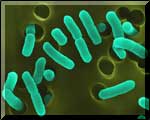
What is E. coli?

Escherichia coli (click here to see video)
Q What is E. coli?
A E. coli is a bacteria that is most commonly found in the intestines of humans and animals. ‘E. coli’ is short for Escherichia coli – and the presence of the disease in water is a strong indication of recent sewage or animal waste contamination, according to the U.S. Environmental Protection Agency. The various strains of E. coli include ones that are harmful to humans, and ones which are not.
Q What are the symptoms and health effects of E. coli O157:H7?
A The E. coli 157:H7 is one of the many strains of the E. coli bacteria, and while most strains are harmless to humans, this particular strain produces a powerful toxin that can cause severe illness and even death. Symptoms associated with E. coli can last approximately 4 days, while lasting longer in some cases. Symptoms, which occur after 24 hours of contamination, include bloody diarrhea, as well as severe abdominal pain. In patients such as children under five years of age, as well as the elderly, the disease can have more adverse effects. It can cause haemolytic ureic syndrome (HUS) after 5 to 10 days of the person being infected. This can lead to anemia, acute kidney failure, low platelet counts, as well as death, in some cases.
Q How is E. coli treatable?
A
The disease can usually be treated with nothing other than re-hydration
and some electrolyte replacement. In
some of the more severe cases, people recover from the disease after taking
antibiotics for approximately 5 to 10 days of treatment.
Q How does the bacteria spread?
A The
bacteria spreads via many sources, including water and food.
The infection can spread in foods such as undercooked
ground
beef, un-pasteurized milk, ham, turkey, roast beef, various sandwich meats,
cheese, raw vegetables, as well as
contaminated water. Once a person
has been exposed to the bacteria, the infection can pass to another person via
hand-to-mouth contact. During times
of precipitation, E. coli bacteria may be washed into creeks, rivers, streams,
lakes, or
groundwater. In our case, contaminated groundwater seeped into Walkerton’s
drinking water system.